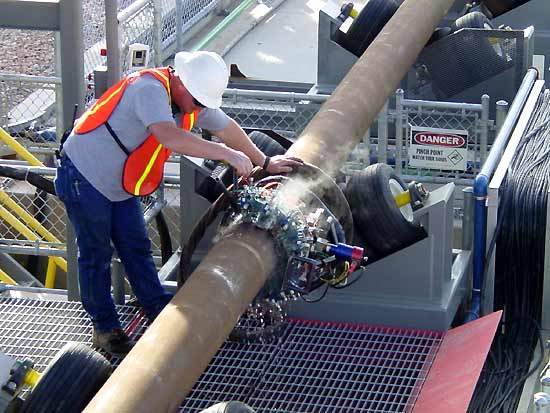Comprehensive Introduction of Pipe Welding Evaluation Treatments
Pipeline welding assessment procedures play an important function in ensuring that bonded connections meet rigid sector requirements and specs. From thorough pre-welding inspections to extensive post-weld assessments, a well-defined inspection process is necessary for keeping the structural sturdiness of pipes.
Pre-welding Inspection Preparations
Prior to beginning the welding procedure, comprehensive pre-welding assessment prep work are necessary to make certain the honesty and quality of the weld joint. These preparations include a thorough evaluation of the products to be bonded, the welding equipment, and the work setting. The products should be checked for any kind of defects, impurities, or variances that might endanger the weld. This includes monitoring for correct product qualities, measurements, and surface area problems. Pipeline Welding Inspection. Furthermore, the welding devices requires to be evaluated to verify that it remains in good working problem, adjusted properly, and suitable for the certain welding process. Any kind of concerns with the tools ought to be dealt with immediately to stop problems in the weld. Finally, the workplace must be reviewed for tidiness, correct ventilation, and precaution to make sure a favorable setup for the welding procedure. By carrying out thorough pre-welding assessment preparations, prospective issues can be recognized and resolved at an early stage, resulting in trustworthy and high-quality weld joints.
Welding Procedure Certification
Comprehensive pre-welding inspection prep work lay the structure for the vital procedure of Welding Treatment Certification, making certain the integrity and high quality of the weld joint. Welding Treatment Certification (WPQ) is an important action in the welding procedure that involves testing and certifying welding treatments to assure they meet particular criteria and needs. The WPQ procedure usually consists of welding procedure specification advancement, welding treatment credentials screening, and documentation of the outcomes.
During welding procedure spec development, vital information such as the welding process, welding products, joint style, and welding specifications are specified to produce a thorough procedure. Subsequently, welding procedure certification screening is conducted to verify the recommended procedure's honesty. This screening commonly involves welding examination discount coupons that go through numerous mechanical and non-destructive examinations to evaluate the weld's quality and adherence to the defined criteria.
In-process Weld Assessment
During the welding process, in-process weld evaluation plays an important duty in making sure the quality and stability of the weld joint - Pipeline Welding Inspection. This sort of evaluation entails monitoring the welding parameters, examining the weld grain formation, and identifying any type of prospective flaws or discontinuities as they occur. By carrying out in-process weld assessments, welding drivers can quickly deal with any concerns that may emerge, thereby making certain and avoiding additional problems that the last weld meets the called for specifications
Typical approaches used for in-process weld assessment include visual examination, liquid penetrant testing, magnetic fragment screening, ultrasonic testing, and radiographic testing. On the whole, in-process weld evaluation is necessary for maintaining the high quality and dependability of bonded pipelines.
Non-destructive Testing (NDT)
Non-destructive Testing (NDT) is an essential method utilized in pipe welding examination to assess the integrity of weld joints without creating damage to the welded framework. By making use of numerous NDT strategies, inspectors can assess the high quality of welds and determine any kind of issues or suspensions that may jeopardize the structural strength of the pipe. Usual NDT approaches made use of in pipe welding examination consist of Radiographic Screening (RT), Ultrasonic Screening (UT), Magnetic Fragment Testing (MPT), Liquid Penetrant Screening (LPT), and Visual Screening (VT)
RT entails using X-rays or gamma rays to produce photos of the interior framework of the weld, enabling examiners to find flaws such as porosity, fractures, or insufficient combination. UT utilizes high-frequency acoustic waves to spot defects below the surface of the weld, offering detailed details concerning the dimension and place of problems. MPT and LPT are used to identify surface-breaking issues by using magnetic bits or penetrant liquids to the weld area. Furthermore, VT includes aesthetic evaluation of welds to recognize any visible blemishes.
Post-weld Examination and Paperwork

Paperwork of post-weld inspection findings is essential for keeping quality control documents and guaranteeing conformity with industry criteria and regulations. In-depth reports should consist of information regarding the examination techniques made use of, the location and nature of any type of defects discovered, and any kind of corrective actions taken - Pipeline Welding Inspection. Correct documentation not only functions as a record of the weld's high quality yet also aids in future upkeep and examination processes
Final Thought

Finally, pipeline welding assessment treatments play an important duty in guaranteeing the high quality and honesty of welds. From pre-welding evaluations to post-weld documents, each action is vital in keeping the safety Check Out Your URL and efficiency of pipelines. By adhering to established procedures and conducting detailed inspections, prospective flaws can be recognized and addressed before they cause pricey repairs or failures. In general, adherence to appropriate assessment methods is vital to the success of pipeline welding projects.
From precise pre-welding evaluations to comprehensive post-weld evaluations, a distinct inspection procedure is vital for maintaining the structural strength of pipelines. By conducting in-process weld evaluations, welding drivers can promptly attend to any kind of concerns that may emerge, therefore avoiding more issues and making certain that the last weld satisfies read review the required requirements.
Usual techniques used for in-process weld examination consist of visual examination, fluid penetrant testing, magnetic fragment screening, ultrasonic testing, and radiographic screening.Non-destructive Testing (NDT) is a critical approach utilized in pipe welding assessment to evaluate the honesty of weld joints without triggering damages to the welded framework. Post-weld assessment involves numerous methods to analyze the welds for problems, consisting of visual examination, dye penetrant screening, magnetic particle screening, ultrasonic testing, and radiographic screening.